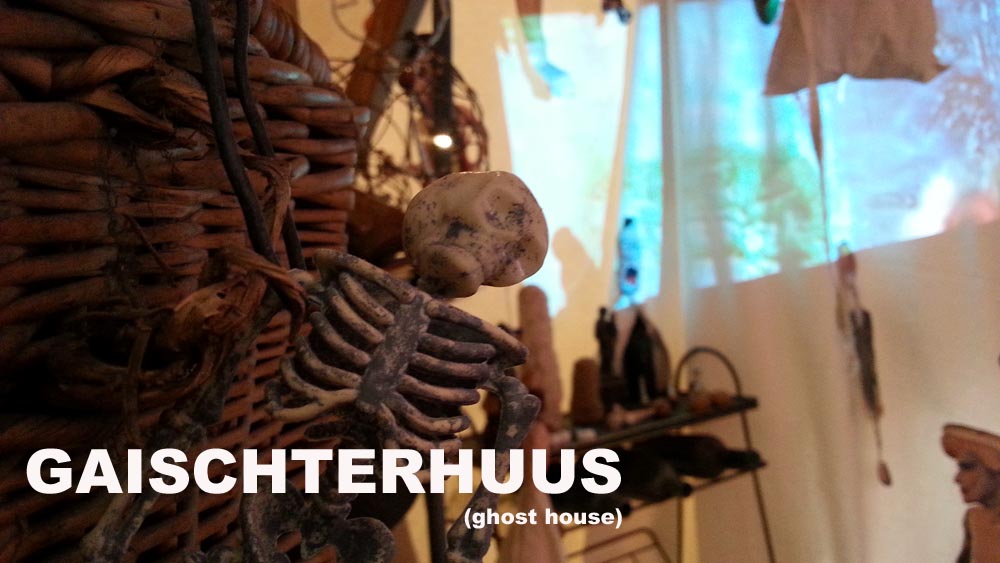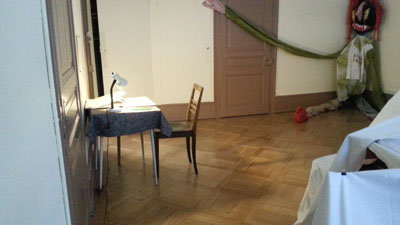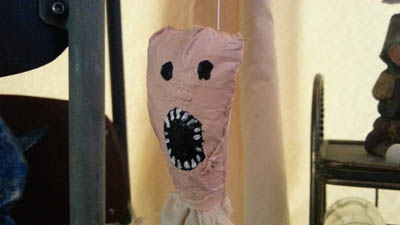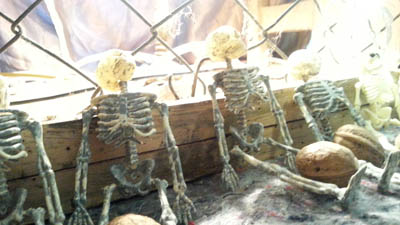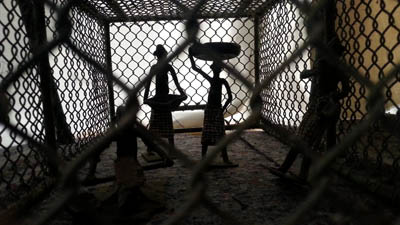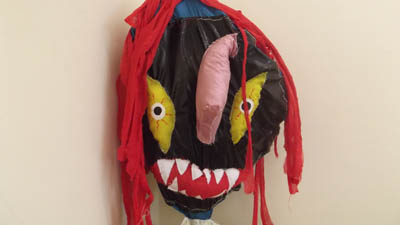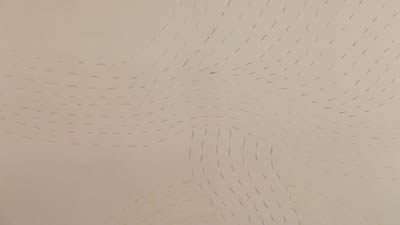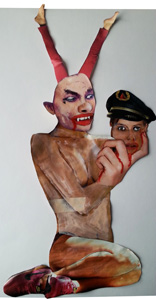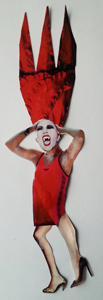jay rechsteiner
home artworks statement & cv contact
...............................................................................................................................................................................................
Gaischterhuus (Ghost House)
(German translation: click HERE)
“Gaischterhuus” is a room installation comprising four interconnected elements. Rather than delving into literal ghosts, it explores personal experiences, decision-making, and the fear associated with one’s own exploration and development - essentially, one’s personal ghosts.
Harmony, poetry, and nostalgia form integral and personal components of this work, providing a dual perspective that looks upon the world with both the wondrous eyes of a child and the rational mind of an adult. The installation’s individual elements create a synergetic composition, weaving an interplay between different experiences, points of view, and positions. It refrains from conveying explicit messages or teachings, allowing visitors to freely associate and explore the work.
The majority of the objects within the installation belonged to my father. While this work addresses the passing of my dad, it extends its scope to encompass broader themes such as the passage of childhood, the complexities of moving forward, and the challenges of being caught in the past.
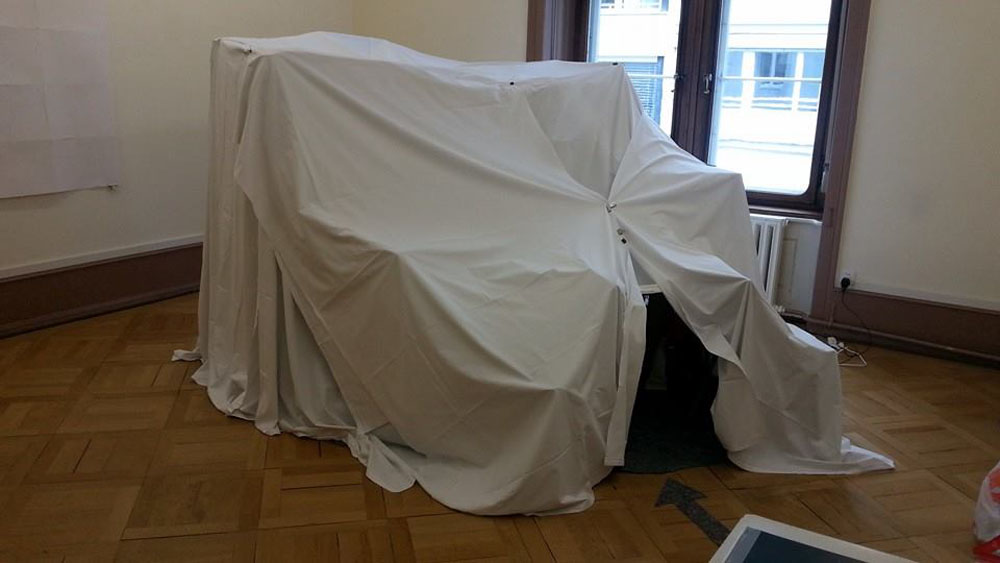
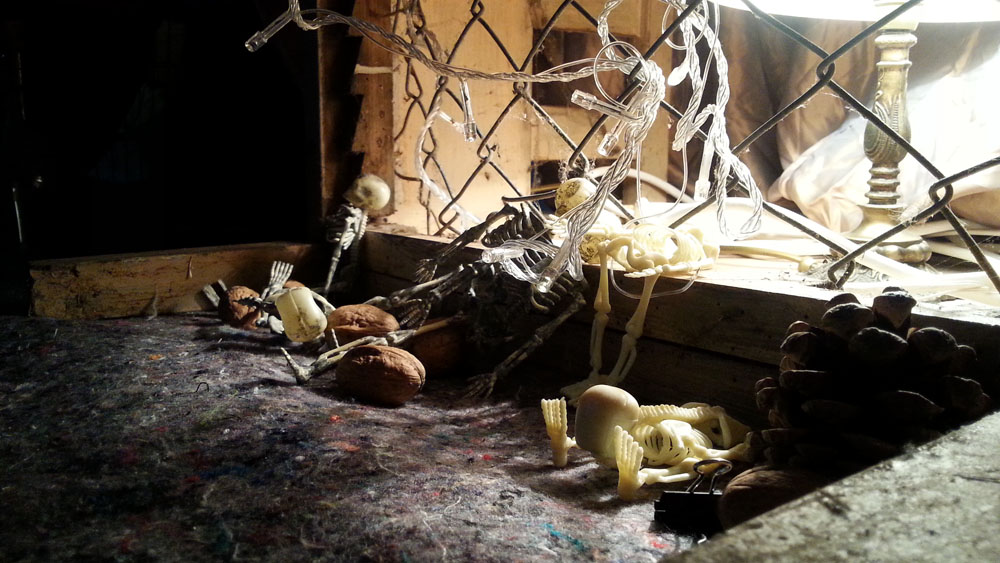
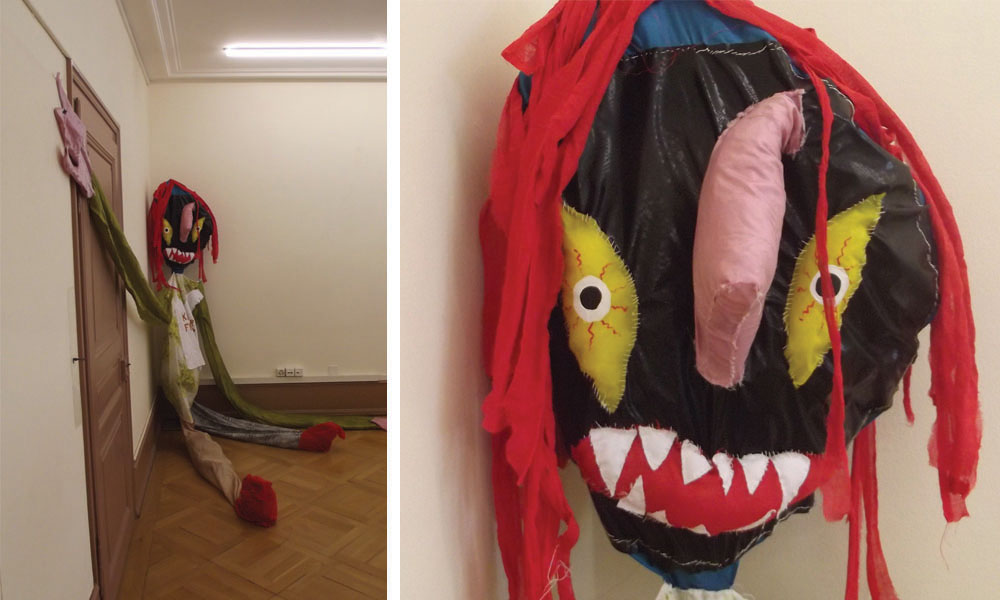
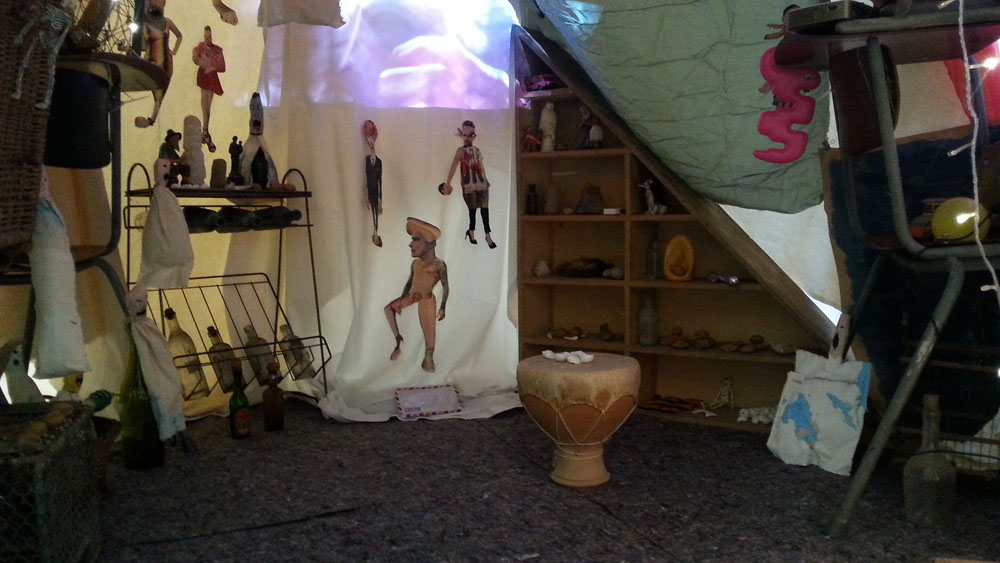
Info
Gaischterhuus construction: The Blue Room - a sculpture
The Blue Room is a magical place where the child in the form of an adult creates its own reality. It is an enclosed space which is full of objects that are in relation to one's imagination of a possible existence beyond this particular space. It is a space where one works, creates and lives. It is a space that is temporary but nevertheless absolute, universal and eternal and where one's activities lead one to this space, the Blue Room.
The construction is a sculpture that consists of various pieces of furniture, bed sheets, fabrics and personal objects I borrowed from the curator Clément Stehlin and from my father Franzueli Rechsteiner. All these objects have a peronal value as some of them are very old and full of history. This puts the installation into a strong context with the curator and my dad because I was only able to construct the Gaischterhuus as it is now thanks to both of them.
The Blue Room does not only exist as part of this installation or within my personal world of thoughts but in the house of my father. It is a very special and peculiar room, that enclosed in itself is a world of its own which is full of souvenirs, magical stones, bones, instruments etc.
Drawing
The drawing consists of 16 A3 sheets and has been executed with colour pencils. It explores the representation of the processes of research, decision making, fear and growing. From afar one cannot see the coloured lines and thinks it is just white, nothing has been drawn. As you come closer, however, the lines slowly emerge. It is important to get closer to the world to explore and finally understand it.
Kinderfresser (Child Eater)
The Kinderfresser is a giant puppet that sits in the corner of the room overlooking everything. It has been cast out of the Blue Room and consists of the same fabrics that also partly decorate the Blue Room in the inside. The puppet reminds one of a carnival figure, the masked creature that sees the world through two holes. This allows him to approach the world in a different manner and hence adapts to this new world. It is scary and mysterious but also wondersome, foreign and nostalgic at the same time.
Film: Inside the Blue Room
This film puts my father into the center of atttention, into the center of (non)activity. He is working in his blue room. He is exploring objects carefully. The background sound have been recorded within the blue room. The film is being projected within the Blue Room construction.
An important aspect of this work is the reduction of my ego. In my opinion artwork shouldn't express the creator's ego. Works are creatures of themselves. I think that really good art (in opposition to artistic work) is univeral, absolute and egoless. The creative's ego manifests in various forms. Whether or not I manage to decrease my ego, is not as important as is the entire work (Gesamtkunstwerk) essential. The process is what counts.
more photos on OneDrive:
|
|
film: Insect
|
Hidden art
As the Gaischterhuus is about exploration I have hidden/integrated a series of photographs and a series of collages within the installation:
Collage monsters made of mainly Vogue magazine model:
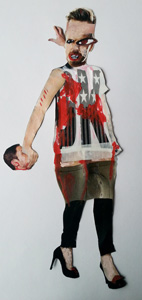 35cm x 15cm |
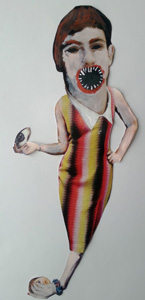 37cm x 15cm |
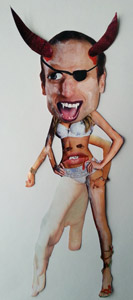 32cm x 12cm |
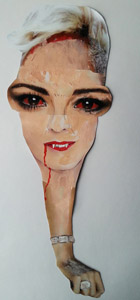 38cm x 14cm |
|
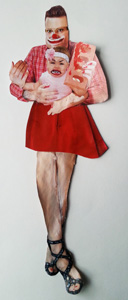 32cm x 10xm |
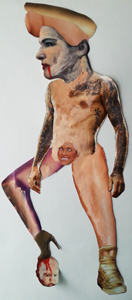 43cm 19cm |
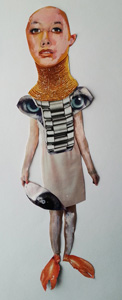 28cm x 8cm |
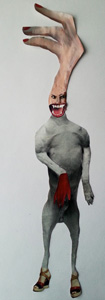 36cm x 7cm |
|
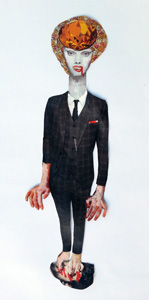 34cm x 10cm |
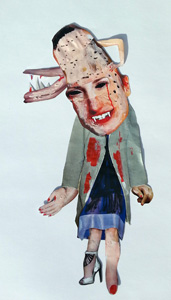 26cm x 12cm |
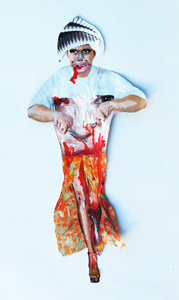 24cm x 12cm |
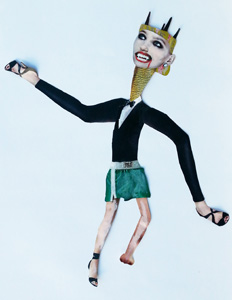 33cm x 30cm |
|
Gaischterhuus (Ghost House)
Gaischterhuus ist eine aus vier verschiedenen Elementen bestehende Rauminstallation. Sie beschäftigt sich nicht mit Geistern im eigentlichen Sinn, sondern eher mit Erfahren, Entscheiden und der Furcht / Vorsicht des Erforschens und Entwickeln des Selbst, in anderen Worten mit den eigenen Geistern. Harmonie, Poesie und Nostalgie sind wichtige und persönliche Bestandteile dieser Arbeit, welche die Welt durch Kinder- und Erwachsenenaugen gleichzeitig betrachtet und erfährt. Die einzelnen Elemente der Installation kreieren eine synergetische Komposition, ein Zusammenspiel verschiedener Erfahrungen, Betrachtungsweisen und Positionen. Es wird nichts gesagt, nichts beigebracht. Der Besucher kann die Assoziationen der verschiedenen Bestandteile selbständig erforschen.
Elemente:
Gaischterhuus-Konstruktion: Das Blaue Zimmer - eine Skulptur
Das Blaue Zimmer ist ein magischer Ort, in welchem das Kind als Erwachsener seine eigene Realität konstruiert. Es ist ein abgeschlossener Ort, in welchem sich etliche Gegenstände, die in Bezug auf die Vorstellung einer möglichen Existenz außerhalb des Ortes stehen, befinden. Es ist ein Ort, in welchem gearbeitet, konstruiert und gelebt wird. Ein Ort, der temporär ist und trotzdem absolut, universell und ewig, da man sich diesen Ort außerhalb dieses Ort vorstellt und seine Aktivitäten einen schlussendlich an diesen Ort, das Blaue Zimmer, führen.
Die Konstruktion ist eine Skulptur, welche aus etlichen Möbeln, Bettlacken, Tüchern und persönlichen Gegenständen des Kuratoren Cément Stehlin und meines Vaters Schlössli besteht. All die Gegenstände haben einen sehr persönlichen Wert, da sie z. T. schon sehr alt und voller Geschichte sind. Dies stellt einen starken Bezug zu meinem Vater und auch zum Kuratoren der Ausstellung dar, da ohne diese Zwei mein Gaischterhuus im jetztigen Zustand nie zustande gekommen wäre.
Das blaue Zimmer existiert nicht nur als Bestandteil dieser Installation und meiner kreativen Gedankenwelt, sondern auch im Hause meines Vaters. Es ist ein ganz besonderes Zimmer, das abgeschlossen in sich eine eigene Welt darstellt, welche mit Erinnungsgegenstände, magischen Steinen, Knochen, Instrumenten usw. vollgestopft ist.
Zeichnung
Die mit Farbstift ausgeführte Zeichnung besteht aus 16 in einem Rechteck angelegten A3-Blättern. Die Zeichnung beschäftigt mit sich der Darstellung des Prozesses Erforschung – Entscheidung – Angst – Vorsicht – Wachsen. Aus der Ferne kann man die Farbstriche kaum erkennen. Nur wenn man sich der Zeichnung nähert, sieht man die Farbstriche. Es geht mir hier ums Erforschen, das nur Zustande kommt, wenn man sich den Dingen 'mutig' nähert.
Kinderfresser
Der Kinderfresser ist eine genähte Riesenpuppe, die in einer Ecke des Raumes sitzt und das Geschehen beobachtet. Sie ist aus dem Gaischterhuus ausgestoßen und besteht aus dem selben Stoffen, welche sich innerhalb des Gaischterhuuses befinden. Die Puppe erinnert stark an eine fas(t)nachtliche Figur, an einen Larventräger, der die Welt durch zwei Löcher ganz anders sieht. Dies erlaubt ihm, sich der Welt in ungewohnter Weise zu nähern und dementsprechen passt sich sein Verhalten auch an. Er ist unheimlich und mysteriös, aber auch wundersam, fremd und nostalgisch zur selben Zeit.
Film: Im Blauen Zimmer
Dies ist ein Film, der meinen Vater in den Mittelpunkt der (Nicht-)Handlung stellt. Er arbeitet in seinem blauen Zimmer. Er erforscht Gegenstände sehr sorgfältig. Die begleitende Hintergrundmusik (Geräusche) sind im selben Zimmer entstanden. Der Film befindet sich in der Gaischterhuus-Konstruktion
Ein wichtiger Aspekt dieser Arbeit ist die Reduktion meines Egos, das wie ein König meine bisherigen künstlerischen Tätigkeit in die Welt hineingeschrien hat. Ich bin der Ansicht, dass Kunst das Ego des Schaffenden nicht reflektieren sollte. Werke sind eigene Wesen. Ich denke, dass wirklich gute Kunst (oder einfach Kunst im Gegensatz zu künstlerischem Werke) universell, absolut und egolos ist. Das Ego des künstlerisch Arbeitenden kann sich in verschieden Elementen der Arbeit widerspiegeln/manifestieren, z. B. in der perfekten Umsetzung von Ideen in malerische Formen oder in einem belehrenden Inhalt. All dies versuche ich zu minimieren oder zu umgehen. Ob es mir gelingt oder nicht, hat keine schwergewichtige Bedeutung, da das Gesamtkunstwerk maßgebend sein wird. Was zählt, ist der Prozess.
